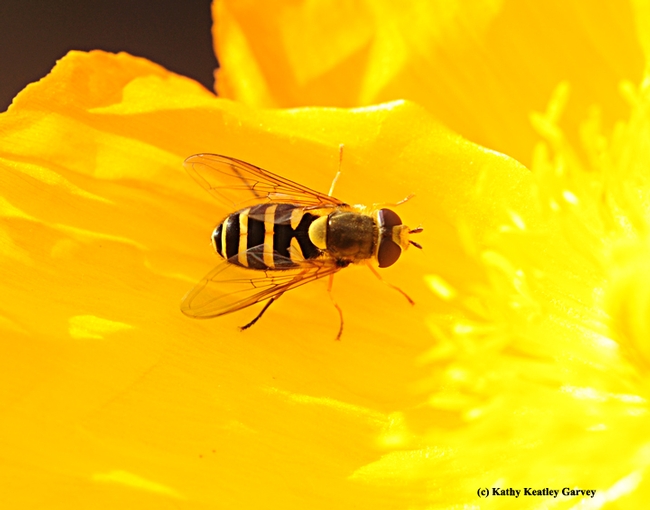- Author: Kathy Keatley Garvey
Set a plate for one and you might get three more diners.
Such was the case recently in a Sonoma garden when a patch Iceland poppy (Papaver nudicaule) drew a posse of hungry honey bees, all elbowing up to the plate.
Iceland poppy is irresistible.
Ironically, you won't find Iceland poppy in Iceland. It's native to the subpolar regions of Europe, Asia and North America and the mountains of Central Asia, according to Wikipedia. Cultivars include yellow, orange, salmon, rose, red, pink cream and white as well as bi-colored varieties.
These honey bees (below, photographed on Nov. 12) seemed to prefer red!
Meanwhile, mark your calendar!
Amina Harris, director of the UC Davis Honey and Pollination Center has scheduled the fourth annual UC Davis Bee Symposium for Saturday, March 3 in the UC Davis Conference Center. Keynote speaker is noted bee scientist Tom Seeley, Horace White Professor in Biology, Department of Neurobiology and Behavior at Cornell University. He's the author of Honey Bee Ecology, Honey Bee Democracy, The Wisdom of the Hive and Following the Wild Bees. The symposium is sponsored by the Honey and Pollination Center and the UC Davis Department of Entomology and Nematology.
Harris has also announced that the second annual California Honey Festival is Saturday, May 5. The venue is the same: Main Street in Woodland. Last year some 20,000 people attended the festival--deemed a veritable bee hive of activity--and even more are expected this year. UC Davis will again be well represented.
More information to come!
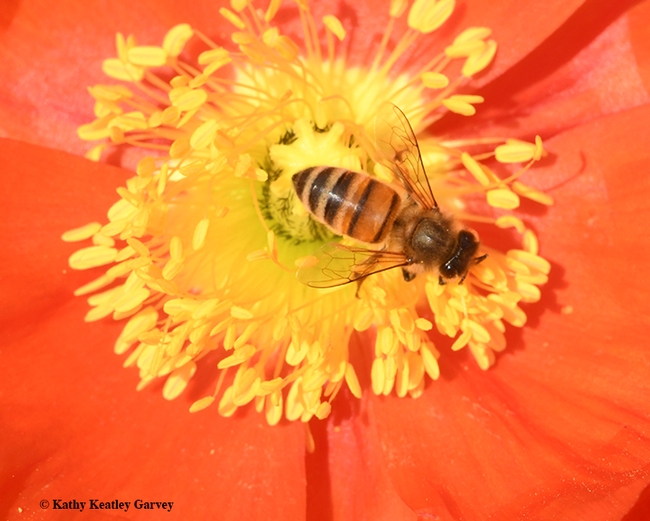
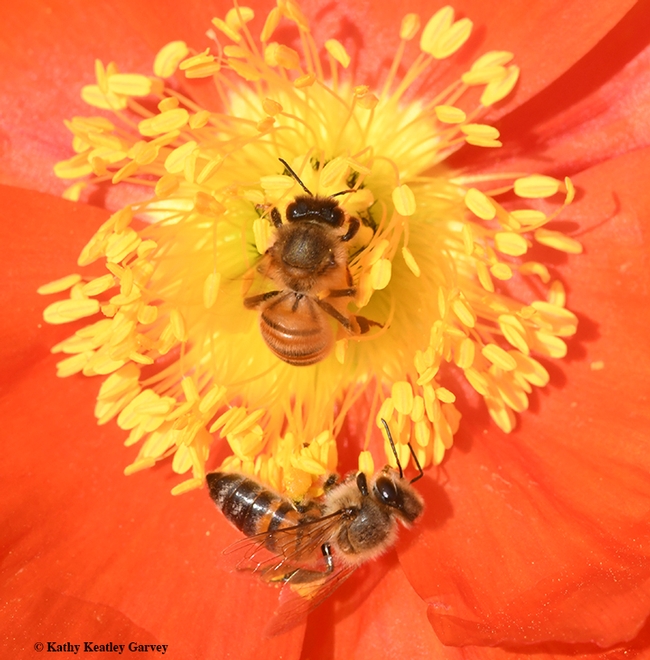
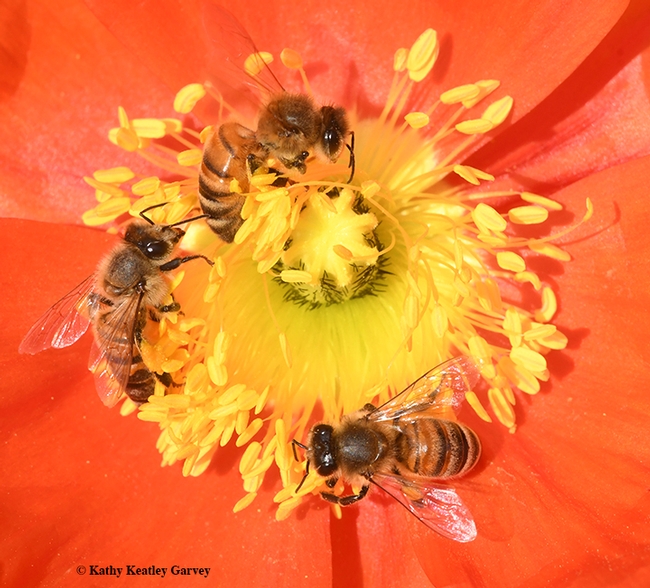
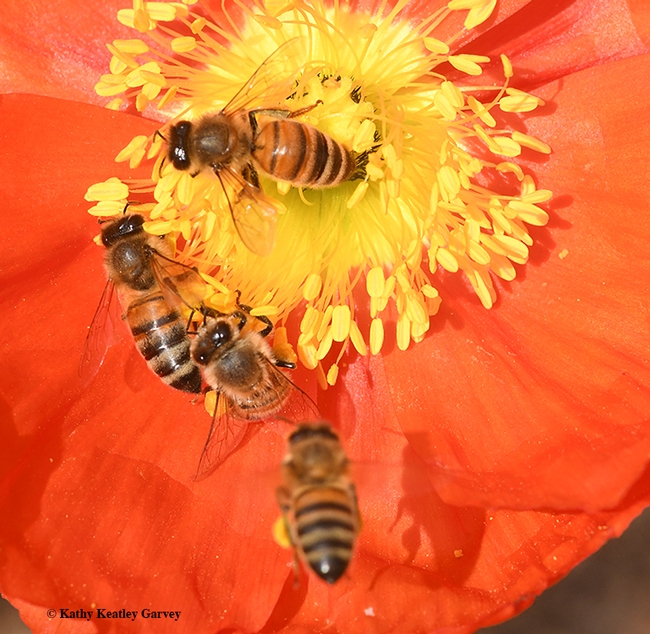
- Author: Kathy Keatley Garvey
Katydids did it.
When it comes to the best of the industrial-strength shredding machines, they're it.
The nymphs have been feeding our Iceland poppies, chewing incredible holes in petal after petal, and then looking around for more. They leave behind what looks like shredded cabbage.
But if you catch them early in the morning with the sun lighting them up, they're kind of beautiful with their thin, angular legs; antennae longer than their bodies; and beady looking eyes fixated at you. The nymphs can't fly, so when disturbed, they merely hop away, camouflaged in the vegetation.
"Katydids occasionally become damaging pests in orchards where broad-spectrum pesticides were not applied or are under minimum tillage programs," according to the UC Statewide Integrated Pest Management Program's Pest Note on Katydids. "High numbers of these pests may occur near raisin and wine grape vineyards, where the do no damage to the fruit."
"Nymphs feed on leaves or fruit early in the spring as they climb from the ground to the tree. Katydid nymphs tend to take one bite out of a fruit before moving on to another feeding site. Hence, a few katydids may damage a large number of fruit in a short time. Feeding wounds heal over and enlarge into corky patches as the fruit expands. The most serious damage occurs when katydids feed on young fruit, which become severely distorted as they develop. Nymphs and adults also chew holes in foliage. Smaller nymphs feed in the middle of the leaf, creating small holes, whereas larger nymphs and adults feed on the leaf edge."
See more information by Googling "katydids UC IPM." You'll find information on UC IPM guidelines for katydids on citrus, nectarine, pomegranate, pear, apricot, plum and other crops.
Meanwhile, those katydid nymphs continue to frequent our Iceland poppies. Other dinner guests--uninvited--are showing up, too. Let's make a hole in one! (Or two, or three!) Let's eat! Let's shred!
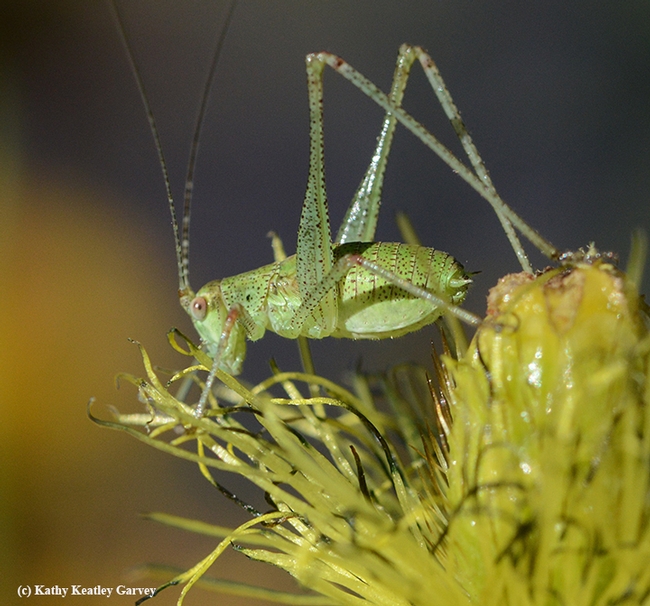
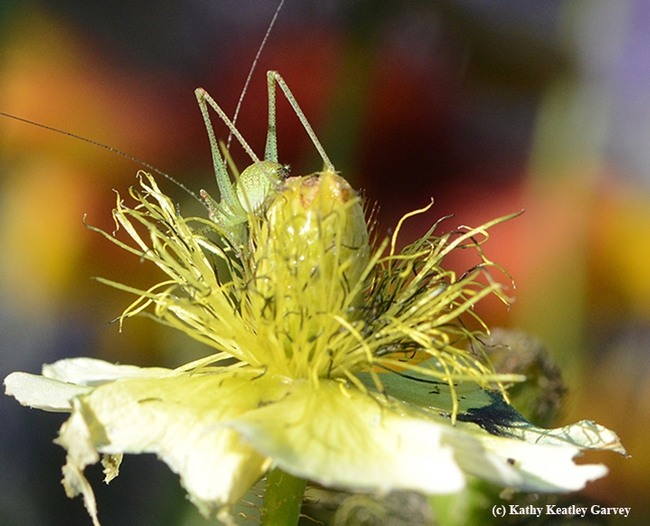

- Author: Kathy Keatley Garvey
Ever seen a mob of tiny sweat bees?
The bees below, from the genus Lasioglossum (as identified by native pollinator specialist Robbin Thorp, distinguished emeritus professor of entomology at the University of California, Davis), just about flash-mobbed an Iceland poppy.
These hungry little bees were a sight to see.
The genus, the largest of all bee genera, contains more than 1700 species in numerous subgenera worldwide, according to Wikipedia. "They are highly variable in size, coloration, and sculpture; among the more unusual variants, some are cleptoparasites, some are nocturnal, and some are oligolectic. Most Lasioglossum nest in the ground, but some species nest in rotten logs."
Why are they called "sweat bees?" Not an attractive name, is it? Well, they're called sweat bees because they're attracted to the salt in human sweat.
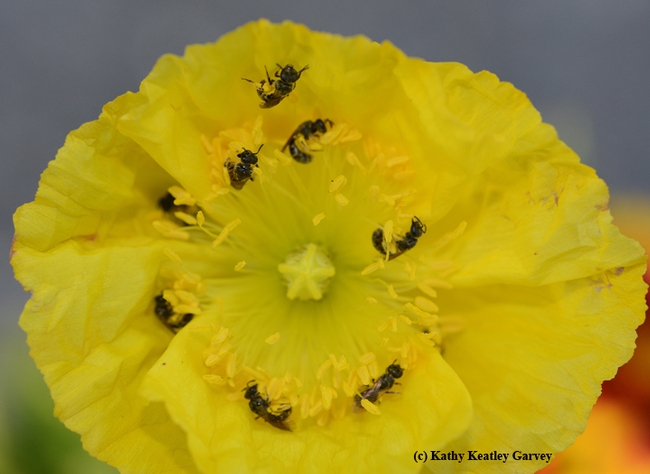
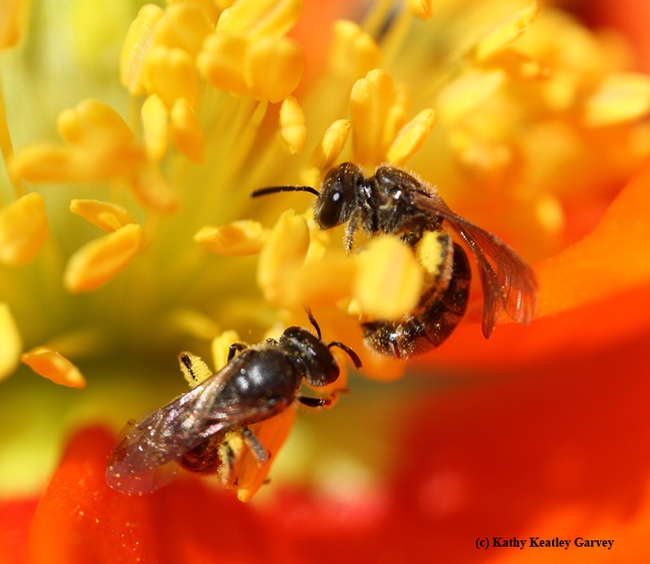
- Author: Kathy Keatley Garvey
The drone fly, aka European hover fly, aka syrphid fly, doesn't get as much press as the other drone, the unmanned aircraft.
But the drone fly (Eristalis tenax), about the size of a honey bee and often mistaken for a honey bee, makes for great in-flight photos. It's sort of the Fat Albert of the Blue Angels.
Last weekend we watched a drone fly (distinguished by the "H" on its abdomen), hovering over an Iceland poppy (Papaver nudicaule). The rain-battered poppy certainly wouldn't have won any gold awards in a county fair's garden show.
But to the drone fly, bent on foraging, this was gold. It emerged with "gold dust" (pollen) on its head.
Yes, its larva are known as rat-tailed maggots and yes, they frequent manure piles, sewage drainage ditches and other water-polluted areas.
But the adults are pollinators. Significant pollinators, at that.



- Author: Kathy Keatley Garvey
It's cool how honey bees and syrphid flies gravitate toward the Iceland Poppy.
It's a winter plant, and frankly, there isn't much to eat out there.
The Iceland Poppy (Papaver nudicaule), a bowl-shaped, papery flower, fills the bill.
The name is a misnomer. It's not native to Iceland. It's from the cooler regions of Europe, Asia and North America, and the mountains of Central Asia. Botanists first described it in 1759.
Like all poppies, they're poisonous. In fact, scientists tell us that all parts of poppies are poisonous. That's because they contain toxic alkaloids. This one, P. nudicaule, contains a benzophenanthidine alkaloid, chelidonine.
Nevertheless, it's a unique, delightful plant. Each flower bursts forth from a hairy, leafless stem that curves like a question mark. When a strong gust of wind further punctuates the plant, the petals drop to the ground. Spent. How fragile are the flowers!
Cultivars can be yellow, salmon, pink, orange, rose, cream and white, as well as tri-colored. The ones in our bee garden are Champagne Bubbles, 15-inch plants in yellow, orange, pink, scarlet, apricot and cream.
Some of the other cultivars bear equally enticing names like Flamenco, Wonderland, Party Fun, Illumination, Meadow Pastels, Victory Giants, Oregon Rainbows and Matador.
Today the honey bees and syrphid flies (aka hover flies or flower flies) jockeyed for position, almost engaging in critter combat in a swirl of autumn color, a veritable kaleidoscope of activity.
Matadors in the Champagne Bubbles...
